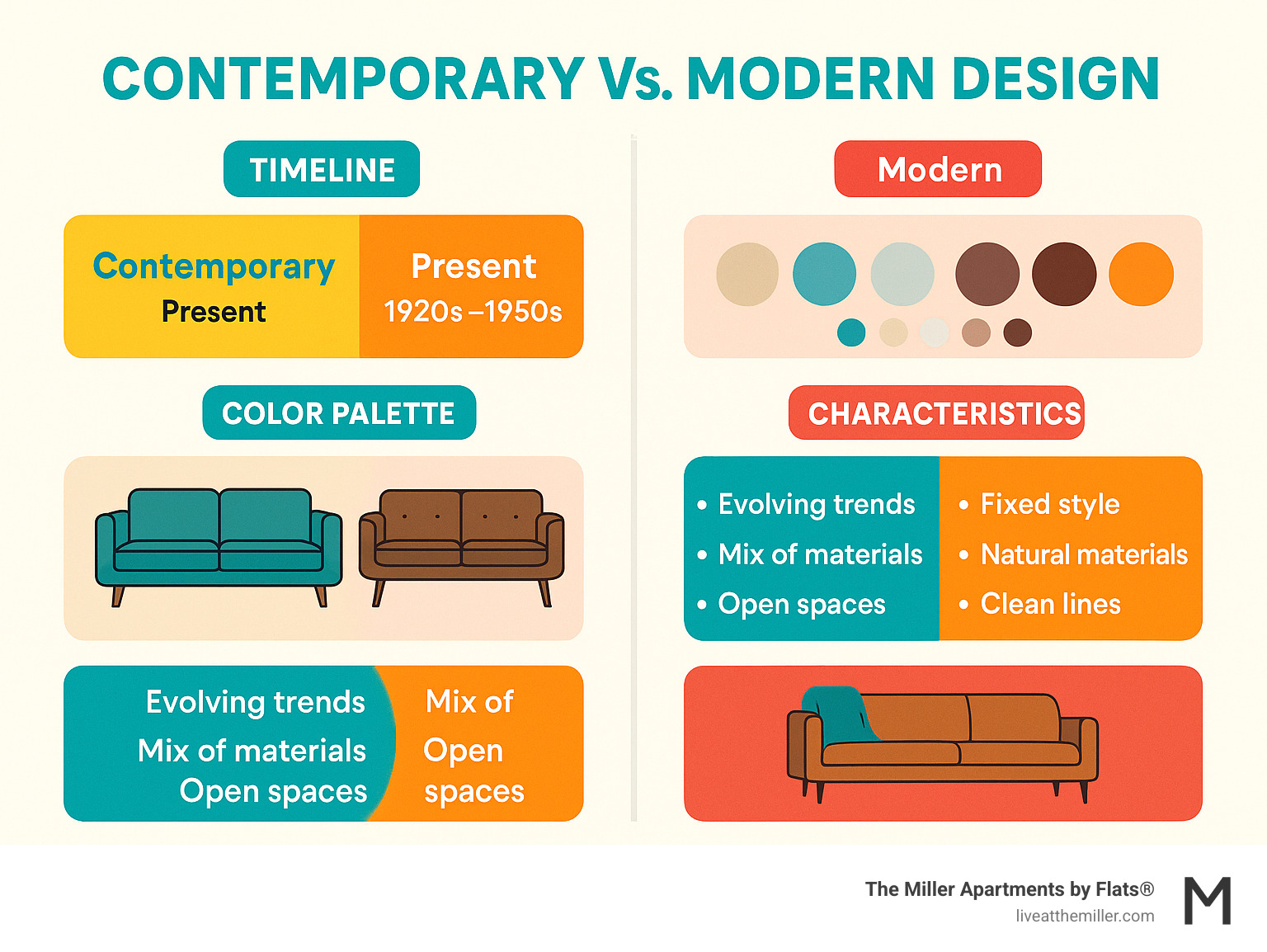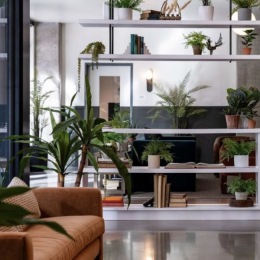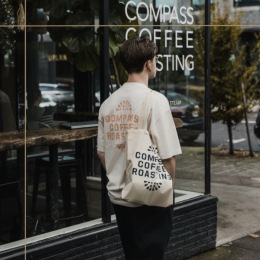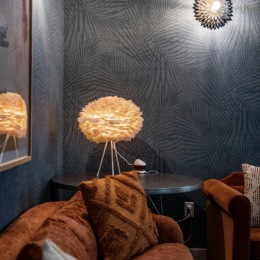What is Contemporary Interior Design?
Contemporary apartment interior design is a fluid, changing style that reflects the "here and now" of current design trends. Unlike modern design, which refers to a specific historical period from the 1920s to 1950s, contemporary design continuously adapts to what's happening today.
Key characteristics of contemporary apartment interior design:
- Clean lines and uncluttered spaces
- Neutral color palettes with strategic bold accents
- Open floor plans that maximize space and flow
- Mix of textures like wood, metal, glass, and stone
- Emphasis on natural light and layered lighting
- Multi-functional furniture that serves multiple purposes
- Minimal but impactful decor that adds personality
Contemporary design prioritizes both form and function, creating spaces that look sophisticated while serving your daily needs. This approach works especially well in apartments, where every square foot matters.
The beauty of contemporary style lies in its adaptability. As one designer noted, "New Yorkers know this better than anyone: In a small apartment, the best solution is to make your space feel bigger and brighter." This philosophy drives contemporary apartment design—creating homes that feel spacious, calm, and effortlessly stylish.
Whether you're working with a studio or a multi-bedroom apartment, contemporary design offers practical solutions that don't sacrifice style for function.
For a broader historical context, you can explore the evolution of contemporary architecture and see how the principles that shape today’s interiors grew out of larger design movements.

The Foundational Principles of Contemporary Apartment Interior Design
When you step into a well-designed contemporary apartment, you immediately feel the difference. There's something about the way everything flows together - the clean lines, the thoughtful use of space, the perfect balance of function and beauty. This isn't accidental. Contemporary apartment interior design follows specific principles that create these harmonious, sophisticated spaces.
The magic happens when clean lines meet open spaces to create an uncluttered feel. Every piece in your apartment should earn its place, serving either a practical purpose or adding genuine beauty to your daily life. This focus on form and function means your space works as hard as you do, supporting your lifestyle while looking effortlessly neat.
Think of your design palette like getting dressed - you start with a neutral base and then add bold accents that show your personality. This approach keeps your space feeling calm and spacious while giving you room to express who you are through carefully chosen pops of color and texture.
Key Color Palettes for a Sleek Look
Your color story begins with neutral foundations - those calming shades of white, cream, beige, gray, and black that make any space feel bigger and brighter. These colors work especially well in apartments where you want to maximize the feeling of space and light. There's a reason designers swear by this approach: it's a designer trick for small spaces that consistently delivers stunning results.
But neutral doesn't mean boring. The real excitement comes from bold accent colors that add personality and energy to your space. These pops of color work best when they come through easily changeable elements like art, rugs, and pillows. Picture a serene gray living room that comes alive with a vibrant abstract painting, or a crisp white bedroom that gets personality from jewel-toned throw pillows.
The secret is restraint. Avoiding overwhelming patterns keeps your space feeling sophisticated and cohesive. When you choose one or two accent colors and use them thoughtfully throughout your apartment, you create a look that feels intentional and polished.
The Role of Light: Natural and Artificial
Light transforms everything in contemporary apartment interior design. Maximizing natural light is your first priority - it makes spaces feel larger, more welcoming, and connected to the outdoors. Sheer curtains are perfect for this, filtering light gently while maintaining privacy. If you're lucky enough to have large windows, let them shine by keeping treatments minimal.
Strategic mirror placement is like having a secret weapon for light. Mirrors don't just reflect light - they bounce it around your space, creating the illusion of more room and brighter days. A well-placed mirror can make a small apartment feel twice as large.
Your layered lighting approach should include three key types: ambient lighting for overall illumination, task lighting for specific activities like reading or cooking, and accent lighting to highlight your favorite art or architectural features. This combination ensures your space looks beautiful and functions perfectly at any time of day.
For more inspiration on how lighting can transform your space, explore more on modern apartment design.
Essential Materials and Textures
The materials you choose set the foundation for your entire space. Natural materials bring warmth and authenticity to contemporary design. Light-colored woods like oak or maple create an airy, clean feeling whether they're on your floors, cabinets, or furniture.
Metal accents add that perfect touch of sophistication. Chrome, nickel, and stainless steel work beautifully for fixtures and hardware, while glass and stone elements like marble or concrete bring different textures and visual interest to your space.
The key to preventing your apartment from feeling cold or sterile is adding warmth with texture. Layer in linen textiles for softness, wool rugs for comfort underfoot, leather furniture for richness, and velvet cushions for luxury. These textures create a space that looks sophisticated but feels like home.
When you combine sleek surfaces with soft textures, you get the best of both worlds - a space that photographs beautifully but also invites you to relax and truly live in it.
Designing for Your Space: Layouts and Overcoming Limitations
Creating a stunning contemporary apartment interior design is all about making the most of what you have – and sometimes, what you don't have. The beauty of contemporary style lies in its ability to transform even the trickiest spaces into something truly special.
Open-concept living is the heart of contemporary design, and for good reason. When you remove barriers between your living, dining, and kitchen areas, something magical happens – your space suddenly feels twice as large. But here's the challenge: how do you create distinct zones without putting up walls?
The secret is in the details. Creating zones becomes an art form when you use furniture arrangement strategically. A well-placed sofa can define your living area, while an area rug anchors the space and tells your eye exactly where one zone ends and another begins. The goal is maintaining that beautiful visual flow while ensuring each area serves its purpose perfectly.
Maximizing Small Contemporary Apartments
Small apartments are like puzzles waiting to be solved – and contemporary design has all the right pieces. The key is making your space feel bigger and brighter, which is exactly what this style does best.
Light color palettes work wonders in compact spaces. Crisp whites, soft creams, and gentle grays are not just pretty—they're practical magic. These colors bounce light around your room, creating an instant sense of openness.
When floor space is precious, think vertical. Wall-mounted shelves and tall furniture draw the eye upward, creating the illusion of soaring ceilings. It's like giving your room a visual stretch. Built-in storage that reaches toward the ceiling maximizes every inch while keeping things sleek and uncluttered.
Low-profile furniture is another clever trick. A low-slung bed or sofa makes your ceilings appear higher than they actually are. Pair this with pendant lights that hang gracefully from above, and you've created vertical interest without eating up floor space.
The real game-changer? Furniture that seems to disappear. Glass coffee tables, acrylic consoles, and other transparent pieces let light flow through them, reducing visual clutter and making your space feel wonderfully open. See modern apartment layouts that master these space-maximizing techniques.
Overcoming Common Apartment Challenges
Every apartment has its quirks – those fixed elements that seem impossible to work around. But contemporary design sees opportunity where others see obstacles.
Low ceilings don't have to feel oppressive. Paint them white or a shade lighter than your walls, and watch them seemingly lift away. Vertical stripes in artwork or wallpaper can elongate a room beautifully, while low-slung furniture creates the illusion of more headroom.
Those fixed architectural elements that seem like eyesores? They're actually opportunities in disguise. Radiators can be concealed with sleek custom covers that blend seamlessly into your design. Awkward columns can become features rather than flaws – paint them an accent color or clad them in a complementary material to make them part of your design story.
Lack of light is perhaps the most common apartment challenge, but it's also the most solvable. Beyond maximizing natural light with sheer curtains, strategic mirror placement can work miracles. A large mirror opposite a window bounces light deep into your room, instantly making it feel brighter and more spacious. Reflective surfaces like polished metals amplify this effect even further.
Using rugs to define zones helps tackle the challenge of open-concept living, creating distinct areas without sacrificing that airy feel.
Creating a Functional Contemporary Apartment Interior Design
The true test of great contemporary apartment interior design is how well it works for your daily life. This is where thoughtful planning really shines.
Defining zones without walls requires creativity. Area rugs anchor seating arrangements and visually separate your living area from your dining space. Open-backed shelving works as gentle dividers, allowing light and conversation to flow while subtly marking different areas.
Strategic furniture placement creates invisible boundaries. The back of your sofa can define the edge of your living area, while a console table marks your entryway. It's about creating structure without sacrificing openness.
Contemporary living demands flexibility, so multi-use areas are essential. Your dining table might double as a workspace, or your guest room could transform into a yoga studio. Home office nooks can be carved out of unused corners, while dining areas in living rooms maximize both space and functionality.
The beauty of contemporary design is that it makes all these solutions look effortless. Your space becomes a seamless blend of style and function, where every element serves a purpose and contributes to the overall harmony of your home.
Smart Furnishings: Multi-Functional and Minimalist Solutions
The hallmark of contemporary apartment interior design extends beyond aesthetics to the very furniture within the space. Pieces are chosen for their clean lines, simple silhouettes, and often exposed legs, which contribute to an airy, uncluttered feel. The aim is to avoid bulky pieces that can visually weigh down a room, especially in apartments where space is at a premium. Instead, every item is selected to improve both the form and function of the home.
Innovative Storage for an Uncluttered Look
Maintaining the sleek, uncluttered aesthetic of contemporary design relies heavily on smart storage solutions. An organized home is a beautiful home, and in an apartment, this means maximizing every inch.
- Built-in cabinetry: Custom cabinetry can seamlessly integrate with your walls, providing extensive storage that appears almost invisible. This is particularly effective in kitchens and living areas.
- Floating shelves: These minimalist shelves offer display space without the visual weight of traditional bookcases, perfect for showcasing curated decor or books.
- Wall-to-wall storage units: In a small apartment, a wall-to-wall dresser or a comprehensive shelving system can maximize a nook or an entire wall, turning it into a powerful storage solution.
- Headboards with storage: Some contemporary bed frames incorporate shelving or hidden compartments within the headboard, providing convenient bedside storage without the need for nightstands.
- Under-bed storage drawers: Utilizing the often-overlooked space beneath your bed for seasonal clothing or extra linens is a classic space-saving trick.
For apartments, it's often advised to "store higher, not wider," utilizing vertical space with wall-mounted solutions. Open shelving, rather than closed cabinets, can also make a space feel larger and more airy.
LIST of smart storage solutions for apartments:
- Integrated wall units and custom cabinetry
- Floating shelves for visual lightness
- Wall-to-wall dressers or shelving systems
- Headboards with built-in storage
- Under-bed drawers and storage containers
- Ottomans and benches with hidden compartments
- Vertical storage solutions like tall, narrow bookcases
- Multi-functional furniture with integrated storage
- Wall-mounted lighting and bedside tables to free up floor space
- Utilizing windowsills for displaying knickknacks
The Power of Multi-Functional Furniture
Multi-functional furniture is the unsung hero of many contemporary apartment interior designs, especially in compact living spaces. These versatile pieces maximize utility without sacrificing style.
- Sofa beds and daybeds: Perfect for accommodating guests without dedicating an entire room, a stylish sofa bed or daybed can transition seamlessly from a comfortable seating area to a sleeping space.
- Nesting tables: A set of tables that tuck neatly into one another offers flexible surface area when needed and compact storage when not.
- Expandable dining tables: Ideal for entertaining, these tables can extend to seat more guests and then shrink back down for daily use, saving precious floor space.
- Ottomans with hidden storage: A chic ottoman can serve as extra seating, a footrest, or even a coffee table, all while concealing blankets, magazines, or other clutter within.
- Coffee tables that lift to desk height: Some innovative coffee tables are designed to lift and extend, changing into a comfortable workspace or a casual dining surface.
- Using stools as side tables: A comfortable stool can function as extra seating, a nightstand, or a convenient side table for drinks and books. One designer even mused, "Who doesn't want a cocktail while shoe shopping?" when describing the multi-functional use of a vintage cabinet for both storage and a bar.
- Murphy beds: For studio apartments, a Murphy bed offers the ultimate space-saving solution, folding away into a wall cabinet when not in use to free up significant floor space.
These pieces are not just practical; they embody the cleverness and adaptability central to contemporary living.
Choosing Visually Lightweight Pieces
To maintain the open, airy feel characteristic of contemporary apartment interior design, choosing visually lightweight furniture is crucial. These pieces contribute to the sense of spaciousness by allowing light and sightlines to pass through them, rather than blocking the view.
- Furniture with legs: Sofas, chairs, and tables that are liftd on slender legs, rather than sitting directly on the floor, create a sense of openness beneath them. This allows the eye to travel further, making the room appear larger.
- Glass coffee tables: A glass tabletop, especially on a minimalist frame, virtually disappears into the room, reducing visual clutter and reflecting light.
- Acrylic consoles and lucite furniture: Transparent materials like acrylic and lucite are champions of visual lightness. A clear lucite console table, for example, can serve its function without imposing on the space, making pieces "virtually disappear." This clever trick improves openness and makes the room feel less crowded.
- Open-backed bookcases: Unlike solid bookcases, open-backed versions allow the wall color to show through and prevent the piece from feeling too heavy.
- Slim profiles: Opt for furniture with thin frames and minimalist designs over bulky, overstuffed pieces.
By incorporating these types of furniture, you can furnish your apartment comfortably and stylishly without making it feel cramped or visually heavy.
Personalizing Your Space Within Contemporary Principles
The magic of contemporary apartment interior design lies in its ability to feel both sophisticated and deeply personal. While the style celebrates clean lines and minimalist principles, it's far from cold or impersonal. The secret is learning to curate rather than clutter, choosing meaningful pieces that reflect your personality while enhancing the overall design.
Think of your contemporary apartment as a gallery where every piece has been thoughtfully selected. You're not filling space—you're creating a story that feels uniquely yours while maintaining that sleek, uncluttered aesthetic that makes contemporary design so appealing.
Incorporating Art and Decor
Art can be a great tool when personalizing a contemporary space. A single large-scale abstract painting can transform an entire wall, injecting personality and color into your neutral palette. The beauty is in the restraint—one stunning piece often makes more impact than several smaller ones competing for attention.
Large-scale photography works equally well, especially black and white images that complement the contemporary aesthetic. Whether it's a dramatic landscape or an urban architectural shot, photography adds sophistication while reflecting your personal taste.
Creating a gallery wall offers another approach, but the key is cohesion. Mix different sizes of frames while maintaining consistency in color or style. Personal photos, abstract paintings, and even small sculptural pieces can work together when unified by thoughtful arrangement and similar framing.
Sculptural objects and decorative vases add three-dimensional interest without overwhelming the space. A single ceramic vase with an interesting form, or a small sculpture that catches light beautifully, can become a conversation starter while maintaining the clean aesthetic.
The art of displaying personal collections thoughtfully means choosing quality over quantity. Whether it's vintage cameras, unique ceramics, or travel mementos, group similar items together on open shelving or within a built-in niche. This creates visual impact while keeping the space organized and intentional.
Using Textiles to Add Warmth and Character
Textiles are a secret weapon for making a contemporary space feel inviting and lived-in. They soften the sleek surfaces and hard edges that define the style, creating a perfect balance between sophistication and comfort.
Throw pillows offer the easiest way to introduce color and texture. Mix different materials like velvet, linen, and faux fur in complementary colors. The variety creates visual interest while maintaining the contemporary feel through coordinated hues.
Cozy blankets draped over a chair or sofa invite relaxation and add that essential tactile element. A chunky knit throw or soft wool blanket provides texture contrast against smooth leather or crisp linen upholstery.
Area rugs do double duty, defining zones while bringing warmth and grounding to a room. They're perfect for introducing a subtle geometric pattern or a pop of color that ties the space together.
Layering different textures creates sophisticated depth even within a neutral palette. Imagine a sleek leather sofa topped with a linen throw, anchored by a wool rug—each material contributes its own character while working together harmoniously.
When choosing textiles with subtle patterns, stick to geometric designs or organic shapes that complement contemporary aesthetics. Bold solid colors work beautifully too, especially when they echo accent colors found in your art or decor.
The Role of Greenery
Plants bring life and energy to contemporary apartment interior design in ways that no other element can match. They provide natural color, improve air quality, and create a sense of calm that perfectly balances the structured lines of contemporary design.
Large potted plants work as living sculptures, anchoring corners and creating focal points. A tall fiddle leaf fig or dramatic monstera can fill empty vertical space while adding organic shapes that contrast beautifully with geometric furniture.
Small succulents scattered on shelves or side tables provide tiny bursts of life without overwhelming the minimalist aesthetic. They're perfect for adding greenery to areas where larger plants wouldn't fit or thrive.
Hanging planters solve the space problem in smaller apartments, adding greenery without consuming precious surface area. They also draw the eye upward, contributing to that sense of height that's so important in contemporary design.
The key is choosing plants that improve rather than clutter your space. A few well-placed, thriving plants will always look better than many struggling ones. Explore modern living room ideas that showcase how thoughtfully placed greenery can lift your entire space.
Conclusion: Creating Your Ideal Contemporary Home
Contemporary apartment interior design offers the perfect blueprint for modern urban living. This style celebrates simplicity, sophistication, and functionality—creating spaces that feel both visually stunning and wonderfully livable. When you focus on clean lines, neutral palettes, strategic lighting, natural materials, and smart multi-functional furnishings, even the smallest apartment can become a serene and stylish sanctuary.
What makes this design approach so appealing is its flexibility. Contemporary style grows and changes with you, ensuring your home always feels fresh and genuinely reflects who you are. It's about creating that uncluttered environment where you can truly relax while making every square foot work harder for you.
The secret lies in proving that compact doesn't mean cramped. With thoughtful design choices, you can achieve that expansive, airy feel that makes coming home such a pleasure. Whether you're working with a studio or a spacious multi-bedroom layout, the principles remain the same: maximize light, accept clean aesthetics, and choose pieces that serve multiple purposes.
The Miller Apartments understands this philosophy completely. Their luxury apartments in Vancouver's Waterfront neighborhood blend modern design with comfort, creating spaces where convenience, comfort, and sophistication naturally come together. With amenities like a day spa, fitness center, and coworking lounge, they've created environments that support the contemporary lifestyle—spaces that truly feel like a personal oasis.
Your apartment should be more than just a place to sleep. It's your retreat from the world, your creative space, and your gathering place for the people you care about. With contemporary apartment interior design principles as your guide, you have everything you need to craft a home that's effortlessly stylish, highly efficient, and uniquely yours.
Find your ideal home with our modern apartment interior design ideas.









